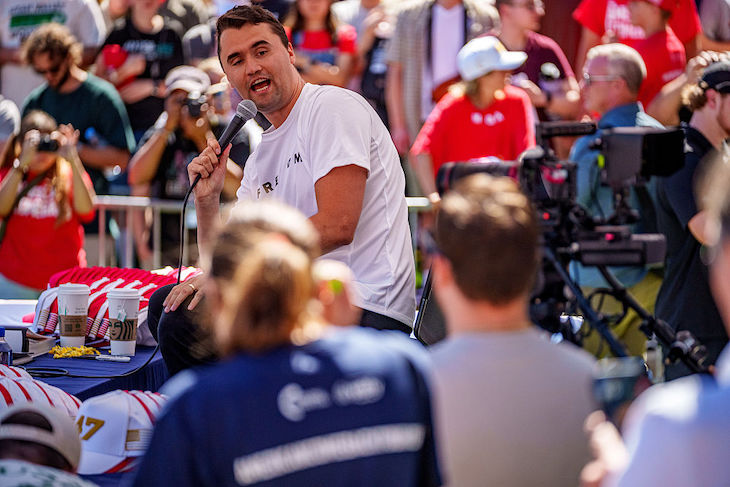Lindt has opened a ‘first of its kind’ flagship store at Piccadilly Circus. Roger Federer was wheeled out to cut the ribbon. It features the UK’s largest Lindt truffle pick ’n’ mix counter (a snip at £6.50/100g), a ‘barista-style’ hot chocolate bar and an ice cream station. There’s even jars of chocolate spread for those who consider Nutella lowbrow.
Lindt’s CEO for UK and Ireland, in that PR corporatese that sounds like guff to everyone except his marketing department, said: ‘With 2025 marking Lindt & Sprungli’s 180th anniversary, what better way to celebrate this journey and enduring passion for captivating chocolate lovers worldwide.’ It’s enough to make me crave Quality Street.
It’s fairly obvious what’s inspired them. A hop and skip down the road is one of those places in London I have never, ever understood: M&M’s World. Just why? M&M’s aren’t even British. A Cadbury factory, fine. A Willy Wonka-esque Bassett’s theme park, complete with life-sized Jelly Babies and a Big Ben made of liquorice allsorts, I might even support. But M&M’s? They’re just knock-off Smarties (indeed, Forrest Mars Snr likely got the idea having encountered Smarties during the Spanish Civil War). Yet tourists flock there. My uncle once splurged £30 on a few M&M’s, personalised with his initials.
The new Lindt store is in the same vein. When I ask a member of staff (they all sport earpieces, like nightclub bouncers) whether Lindt chocolate is Swiss or Belgian he says he’ll need to check with a colleague. One thing he does know about is their version of the viral pistachio and knafeh ‘Dubai chocolate’ – though it had sold out. Nothing screams timeless mastery and secret recipes passed down through the generations more than jumping on to the latest social media bandwagon. Even if I could afford £10 a bar, I’m not in Dubai and have no desire to be (except occasionally when filling out my self-assessment).
The famous Lindt Master Chocolatiers are meant to be on hand but on my first visit their kit had broken down because of the unexpected crowds. I returned in anticipation, but where in the TV adverts they’re masterly craftsmen in foot-tall toques swirling silky-smooth stuff, in store they are reduced to harassed-looking shop assistants behind Covid-reminiscent screens, visibly beginning to wonder whether they might not have been better off flipping burgers in Five Guys across the square.
I meet a contented couple (‘We’ve found flavours here we thought they’d stopped making – it’s like finding a long-lost child!’). And there is one redeeming feature: Lindt has leaned into Easter. For a holiday that long ago seems to have become depressingly pagan, with the chocolate gods surpassing the resurrected Christ as most people’s primary object of adoration, this is hardly surprising. Nonetheless, in a world where the public realm has mostly forgotten this obscure Christian festival exists, it is quite a cheering thing. But not even that can disguise the insipidness of the store.
When I ask a member of staff (they all sport earpieces, like nightclub bouncers) whether Lindt chocolate is Swiss or Belgian he says he’ll need to check with a colleague
The sad thing about all this is that I love Lindt. The thin bars have always felt to me the most luxurious of the big-brand chocolates; housed in cardboard whilst all their competitors exist in mere paper. The perfectly square pieces stand out proudly in a rectangular world. And those Lindor balls are the primus inter pares of the Lindt family; melted slowly on the tongue, or one in each cheek, like a greedy squirrel.
Brits are willing to fork out for quality chocolate. The sector is growing and upmarket brands like smug Tony’s Chocolonely have seen sales rise. Lindt has cemented itself as the middle-class chocolate of choice, with Lindor the UK’s seventh most popular brand according to the Grocer’s data last year (and it took an incredible second place in 2022). This is largely down to adults, mere Smarties being now for kids’ parties.
Taking up almost the entire shopfront directly underneath the electric billboards, Lindt has bagged one of the most high-profile retail locations in the country. But is this really the best we can come up with? Could it not have been an opportunity to champion a national brand? Here in 1910, Bovril became the first product to be advertised by neon lights.
The trend of creating ‘immersive experiences’ for customers continues unabated. Hence also the coming 50,000 sq ft, £73 million Guinness destination in Covent Garden. Where once it was enough to provide a quality product sold by a human at the till and then taken home to enjoy, brands now feel the need to titillate and arouse – and that’s just the bouncer frisking you on leaving, which is surely only a matter of time at the Lindt store
I get that if the high street is to survive shops are going to have to lean in more to providing an exquisite retail ‘experience’. I just wish that the marketing gurus would realise that rather than theme park-style concept stores, a first-rate experience could include a traditional shop, staffed by knowledgeable people that have a genuine interest in the product they’re selling. Throw in the odd free taster and some nice wrapping, and that’s a shop I would be happy to frequent even if it were a little more expensive than online. Too much to ask? Maybe I should just stick a Lindor in my mouth and shut up.








Comments